#university of tasmania ranking
Explore tagged Tumblr posts
Text
0 notes
Text
Discover the Benefits of Study in Australia: A Life-Changing Experience
Australia has long been a top destination for international students seeking quality education, vibrant culture, and stunning landscapes. Whether you're looking to advance your career, improve your English skills, or experience a new way of life, studying in Australia offers countless benefits that make it an enriching life experience. Here's a look at why Australia should be at the top of your list when considering studying abroad.
1. World-Class Education System
Australia is home to some of the world’s most prestigious universities and colleges, offering a wide range of programs that are recognized globally. Institutions like the University of Sydney, University of Melbourne, and Australian National University consistently rank among the best universities in the world. The Australian education system focuses on innovation, research, and practical skills, ensuring that students are well-prepared for the global job market.
2. Cultural Diversity
Australia’s multicultural society is one of its defining features. With people from all over the world, you’ll have the chance to interact with a diverse group of peers, enhancing your cultural understanding and broadening your global perspective. This exposure to different cultures makes for a rich and rewarding study experience, fostering personal growth and lifelong connections.
3. Work Opportunities During Study
Australia allows international students to work part-time while studying, which is a great opportunity to gain work experience and supplement your finances. You can work up to 40 hours per fortnight during the academic semester and full-time during vacations. This helps students integrate into the local community, practice their English, and gain practical experience in their field of study.
4. Post-Graduation Opportunities
One of the key advantages of studying in Australia is the post-graduation work visa program. Graduates can stay in Australia for up to four years (depending on their qualification level) after completing their studies, offering the chance to gain professional experience in Australia and potentially transition to permanent residency. This makes Australia an attractive option for students looking to build their careers on an international scale.
5. High Quality of Life
Australia is known for its high standard of living, with world-class healthcare, public safety, and clean, green spaces. Whether you’re living in a bustling city like Sydney or Melbourne or a more relaxed environment like Queensland or Tasmania, you’ll have access to some of the best living conditions in the world. The combination of great weather, a thriving cultural scene, and a healthy outdoor lifestyle makes it an ideal place to live and study.
6. Beautiful Natural Environment
Australia’s natural beauty is unmatched. From the stunning beaches of the Gold Coast to the breathtaking landscapes of the Outback, you’ll find opportunities to explore unique ecosystems and natural wonders that few other places can offer. Outdoor activities such as hiking, surfing, and snorkeling in the Great Barrier Reef are just some of the amazing experiences waiting for you.
7. Safe and Welcoming Environment
Australia is known for being one of the safest countries for international students. The government takes student safety seriously, with strict laws in place to protect students both on and off-campus. Additionally, Australia’s friendly and welcoming nature makes it easy for international students to adjust and feel at home.
8. Global Networking Opportunities
Studying in Australia opens up a world of networking opportunities. With many international students coming from different corners of the globe, you’ll be able to form connections that can help you both personally and professionally. Australia’s status as an international hub for research, business, and technology means that you’ll be connected to industries that are crucial to the global economy.
Why Grace International is Your Ideal Consultant for Studying in Australia
Choosing the right consultancy is crucial when planning your study abroad journey, and Grace International stands out as one of the best study-in-Australia consultancies in Delhi. As a trusted educational consultant, Grace International offers personalized guidance, ensuring that you are well-prepared for every step of your study abroad journey.
With a team of experienced counselors, Grace International helps students with course selection, university admissions, visa applications, and pre-departure services. They understand the complexities of the application process and provide expert advice to maximize your chances of success.
Whether you're looking for information on Australian universities, financial aid options, or post-study work opportunities, Grace International is dedicated to making your dream of studying in Australia a reality. Their reputation as a top study-in-Australia consultancy in Delhi speaks volumes about their expertise and success in helping students achieve their academic and professional goals.
Conclusion
Studying in Australia offers numerous benefits, from world-class education to vibrant cultural experiences and excellent career prospects. With its welcoming environment, high quality of life, and endless opportunities for growth, Australia is truly a life-changing destination for students.
To ensure that your study abroad journey is as smooth and successful as possible, partner with a trusted consultancy like Grace International, the top choice for students planning to study in Australia. Let Grace International guide you to a future full of academic success and global opportunities.
#study in ireland#study in usa#study in new zealand#study abroad consultants#study abroad programs#study in australia
0 notes
Text
Top 5 Affordable Cities in Australia for International Students
Australia is a premier destination for international students seeking quality education and a multicultural experience. While the country is known for its high living standards, some cities are more affordable than others. This article explores the top 5 affordable Australian cities for international students, highlighting their unique attributes, costs, and educational offerings.
Why Choose Australia for Your Abroad Education?
Before diving into specific cities, it’s essential to understand why Australia is an attractive option for international students. Australia is home to some of the world’s top-ranked universities, providing a wide range of courses that cater to various interests and career paths. Additionally, the country’s diverse culture, stunning landscapes, and friendly locals make it an exciting place to live and learn.
Benefits of Studying in Australia
Quality Education: Australian universities consistently rank highly in global university rankings, ensuring that you receive a quality education that is recognized worldwide.
Multicultural Environment: With students from all over the globe, studying in Australia allows you to experience diverse cultures, fostering personal growth and global understanding.
Work Opportunities: International students in Australia are allowed to work part-time during their studies, which can help cover living expenses and gain valuable work experience.
Post-Study Work Visas: Australia offers post-study work options for international graduates, allowing you to gain professional experience in the country after completing your degree.
Now, let’s explore the top five affordable cities for international students in Australia.
Adelaide
Overview
Adelaide, the capital city of South Australia, is often hailed as one of the most affordable cities for students. Known for its vibrant culture, festivals, and beautiful parks, Adelaide offers a comfortable lifestyle at a lower cost than other major Australian cities.
Cost of Living
Accommodation: The average rent for a shared apartment is approximately AUD 250-350 per week, making it budget-friendly for students.
Food and Groceries: Monthly grocery expenses typically range from AUD 300-400, allowing for a decent diet without overspending.
Educational Institutions
Adelaide is home to reputable universities such as:
University of Adelaide: Known for its strong research programs and international collaborations.
Flinders University: Offers a wide range of undergraduate and postgraduate courses with a focus on practical learning.
Lifestyle and Attractions
Adelaide boasts a relaxed lifestyle, with numerous festivals, galleries, and parks. The city is also known for its wine regions, such as the Barossa Valley, making it an ideal place for students who enjoy exploring new experiences.
Hobart
Overview
Hobart, the capital of Tasmania, is a hidden gem known for its stunning natural landscapes and artistic community. This compact city offers a unique blend of urban and rural life, making it an attractive option for international students.
Cost of Living
Accommodation: Students can find shared housing for around AUD 250-300 per week, significantly lower than larger cities.
Food and Groceries: Monthly grocery costs average AUD 300-350, with fresh produce readily available.
Educational Institutions
Hobart is home to the University of Tasmania, which is known for its research excellence, particularly in marine and environmental studies. The university offers a supportive environment for international students.
Lifestyle and Attractions
Hobart’s vibrant arts scene, historic architecture, and beautiful waterfront make it a delightful place to live. The city is also a gateway to breathtaking natural attractions, including the iconic Mount Wellington.
Brisbane
Overview
Brisbane, the capital of Queensland, is known for its sunny climate and friendly atmosphere. As one of the largest cities in Australia, Brisbane offers a vibrant urban experience combined with outdoor activities.
Cost of Living
Accommodation: The average rent for a shared apartment is around AUD 400-500 per week, which is competitive compared to Sydney and Melbourne.
Food and Groceries: Monthly grocery expenses typically range from AUD 300-450.
Educational Institutions
Brisbane boasts several top universities, including:
University of Queensland: A globally recognized institution known for its research and teaching excellence.
Queensland University of Technology: Offers a wide range of practical courses, particularly in technology and creative industries.
Lifestyle and Attractions
Brisbane is known for its cultural diversity, with numerous festivals and events throughout the year. The city offers beautiful parks, a vibrant nightlife, and access to stunning beaches within a short drive.
Perth
Overview
Perth, located on Australia’s west coast, is known for its stunning beaches, outdoor lifestyle, and warm climate. It is an excellent choice for international students seeking an affordable yet high-quality education.
Cost of Living
Accommodation: Rent for shared accommodation averages around AUD 450-550 per week.
Food and Groceries: Monthly grocery costs typically range from AUD 350-450.
Educational Institutions
Perth is home to several reputable universities, including:
University of Western Australia: Known for its strong research focus and excellent academic programs.
Curtin University: Offers a wide range of courses and has a strong reputation in engineering and technology.
Lifestyle and Attractions
Perth is famous for its beautiful beaches, parks, and outdoor activities. The city offers a relaxed lifestyle, with numerous cafes, restaurants, and cultural events.
Darwin
Overview
Darwin, the capital of the Northern Territory, offers a unique living experience for international students. Known for its tropical climate and rich Indigenous culture, Darwin is a smaller city that provides a close-knit community feel.
Cost of Living
Accommodation: The average rent for shared accommodation is around AUD 350-450 per week.
Food and Groceries: Monthly grocery expenses typically range from AUD 300-400.
Educational Institutions
Charles Darwin University is the primary institution in Darwin, known for its strong emphasis on Indigenous education and research. The university offers a variety of programs tailored to international students.
Lifestyle and Attractions
Darwin’s tropical climate and proximity to natural wonders, such as Kakadu National Park and Litchfield National Park, make it an exciting place to explore. The city hosts various cultural events and festivals that celebrate its diverse community.
Conclusion
Choosing an affordable city in Australia for your studies can significantly impact your overall experience as an international student. Adelaide, Hobart, Brisbane, Perth, and Darwin all offer unique opportunities, vibrant cultures, and quality education at a lower cost of living compared to larger cities like Sydney and Melbourne.
If you’re considering studying abroad in Australia, Reyna Overseas is here to help! Contact us today for expert guidance on choosing the right city and university to suit your educational and budgetary needs. Let us help you make your study abroad dreams a reality!
0 notes
Text
Top- Ranked MBA Courses in Australia for International Students
Comparative Analysis of Top Online MBA Courses in Australia
Australia is an excellent place to start your career with an MBA. Top-class universities and a business atmosphere are here in this country to give you the right nudge to your aspirations. With that said, there are hundreds of MBA courses in Australia for international students. How will you choose the right one?
This guide here gives you the freedom to pick from the best MBA colleges in Australia. You’ll also know about the different MBA course fees in Australia as well. Keep reading.
Universal Business School
Pursuing an MBA from Universal Business School in Australia should be on your priority list. This is one of the best MBA colleges in Australia. This could be your best shot to becoming an entrepreneur or a better leader in your business. We have three campuses all over the country – Melbourne, Sydney and Adelaide. This is the best online MBA course in Australia that you must take.
Accreditation: TEQSA
Duration: 2 years
Qualification: A bachelor degree or proven work experience
Curriculum
Cost: 31920 AUD
Delivery format:
University of New South Wales
Australian Graduate School of Management (AGSM) at the University of New South Wales Business School offers a well-known online MBA program. You can take it full-time or part-time.
Accreditation: CMI
Duration: 1 year
Qualification: An undergraduate degree or 2 years of proven work experience
Cost: AUD 3,370 / per course
Delivery format: On campus
How to apply: Via UNSW’s online application portal
University of Tasmania
The University of Tasmania in Launceston offers a Master in Business Administration in Maritime Management. This MBA course Australia is perfect for those who are looking to gain skills in the Maritime industry. It also offers 8 core subjects including Strategic Management, Commercial Ship Management and Finance for Decision-Making. You'll also have the options to specialize in subjects like Maritime Logistics and Maritime Technology.
Accreditation: CRICOS
Duration: 1.5 years
Qualification: A bachelor degree or 2 years of proven work experience
Cost: 34,950.00 AUD per year
Delivery format: Off campus, on campus
How to apply: Via UTAS's online application portal.
Edith Cowan University
Edith Cowan University in Perth makes you an exceptional leader and a wonderful manager with their online MBA course. It offers 14 specializations including Human Resource Management, Marketing, and Project Management to make a career of your choice.
Accreditation: AACSB
Duration: 18 to 24 months
Qualification: A bachelor degree or 3 years of management experience
Curriculum: 8 core subjects, 8 Entrepreneurial streams, 8 accounting streams
Cost: 57,800 / 43,580 AUD
Delivery format: On and off campus
James Cook University Online
Whether you're just starting out or looking to upskill, there's a program to fit your needs and learning style. James Cook UNiversity offers flexible courses and a chance to interact with national and International students.
Accreditation: IPM
Duration: 1.5 years
Qualification: A Bachelor degree or 4 year managerial experience
Curriculum: Core subjects are finance, marketing, Entrepreneurship, Project Management, Tourism and hospitality, and leadership, with a focus on innovation and adaptability. Elective options allow for specialization.
Cost: $30,636.00
How to apply: Via JCU's online application portal.
University of Southern Queensland (USQ)
The University of Southern Queensland (USQ) offers an online MBA program designed for working professionals. This could be the perfect opportunity for you to upskill while balancing your work.
Accreditation: AHRI
Duration: 8 weeks of teaching period
Qualification: A bachelor degree or 3 years of proven work experience
Curriculum: specialization in Digital Marketing, Human Resource Leadership, Information Management Systems, Leadership,Managing Cyber Risk, Organisational Project Management
Cost: $29360
Delivery format: Online
How to apply: Via USQ’s online application portal
You have to select the best online MBA course in Australia according to your needs and preferences. At Universal Business School, we offer the best online course you’’ ever find in business. Feel free to explore our website to know more.
0 notes
Text
youtube
Level 1 is an informal term used to refer to the top ten colleges/ universities in Australia. They are globally recognised and provide world-class education systems, research opportunities, infrastructure and so on, making the country a sought after study destination.
According to QS World Ranking 2023, Level 1 colleges in Australia are:Australian National University (ANU) University of Melbourne University of Sydney University of New South Wales University of Queensland Monash University University of Western Australia University of Adelaide University of Technology Sydney University of Wollongong
Apart from the universities mentioned above, Australia also has Level 2 colleges that are good but smaller, and lesser globally recognised universities and are slightly easier to get into. The Level 2 universities are:RMIT University The University of Newcastle, Australia (UON) Curtin University Macquarie University Queensland University of Technology (QUT) Deakin University University of Tasmania Swinburne University of Technology Griffith University La Trobe University
How to apply to Level 1 Colleges in Australia?Choose your course. Check your eligibility. Gather the required documents. Get your financial statements in order. Submit your application. On getting your acceptance, apply for OSHC. Begin your student visa application process.
Learn about the Level 1 Australian universities and how to get into them through this super quick video.
You can also gain in-depth knowledge about these universities by reading our article: https://tcglobal.com/level-1-universities-in-australia/
0 notes
Text
https://shreehari.in/top-ranking-institutes-to-study-in-australia/
Top Ranking Institutes to Study in Australia
Australia is renowned for its world-class education system, diverse culture, and stunning landscapes. Choosing the right institute is crucial to ensure a rewarding and successful educational journey in Australia. In this article, we will explore some of the top ranking institutes in Australia, including universities, vocational education and training (VET) institutes, and specialized institutions.
Australia offers a wide range of educational opportunities for students from around the world. When considering studying in Australia, it is important to evaluate various factors such as academic reputation, program offerings, location, and support services.

Factors to Consider When Choosing an Australian Institute
Before exploring the top-ranking institutes, consider the following factors to help you make an informed decision:
Academic reputation: Research the institute’s reputation for academic excellence and the quality of teaching and research.
Program offerings: Determine if the institute offers programs and courses that align with your academic and career goals.
Location: Consider the location of the institute and the lifestyle and opportunities available in that area.
Support services: Assess the support services provided by the institute, including career guidance, accommodation assistance, and student organizations.
Research opportunities: Explore the institute’s research facilities, industry partnerships, and opportunities for hands-on learning.
Scholarships and funding: Investigate the availability of scholarships, grants, and financial aid to support your studies.
Top-Ranking Universities in Australia
The University of Adelaide
Recognized for its strong research focus and high-quality education.
Offers a wide range of programs in fields such as humanities, sciences, engineering, health sciences, and business.
Known for its state-of-the-art facilities, supportive learning environment, and engagement with industry.
University of South Australia
A leading institution known for its industry connections and practical, career-focused programs.
Offers a diverse range of programs in areas such as business, engineering, health sciences, and arts.
Provides opportunities for work-integrated learning and industry placements.
University of Tasmania
Located in the picturesque island state of Tasmania, known for its natural beauty and vibrant arts and culture scene.
Offers a wide range of programs, including sciences, humanities, social sciences, business, and creative arts.
Known for its research strengths, collaborative learning environment, and supportive academic staff.
University of Victoria
A prestigious institution with a strong focus on research and innovation.
Offers a broad range of programs in fields such as sciences, arts, business, engineering, and law.
Provides excellent facilities, research opportunities, and a diverse and inclusive campus community.
Deakin University
Known for its innovative approach to education and strong industry connections.
Offers a wide range of programs across various disciplines, including arts, business, health sciences, and engineering.
Provides opportunities for practical learning, internships, and work placements to enhance students’ employability.
University of Wollongong
Renowned for its teaching excellence and research strengths.
Offers a comprehensive range of programs in areas such as sciences, engineering, arts, business, and health sciences.
Provides a supportive and multicultural campus environment with state-of-the-art facilities.
University Technology Sydney
A dynamic institution known for its focus on practical learning and industry engagement.
Offers programs in fields such as engineering, information technology, business, design, and communication.
Provides access to cutting-edge facilities, industry partnerships, and a vibrant student life in the heart of Sydney.
Macquarie University
Recognized for its innovative and interdisciplinary approach to education.
Offers a wide range of programs in areas such as sciences, business, humanities, social sciences, and psychology.
Known for its research strengths, global connections, and campus facilities.
University of Canberra
Located in the capital city of Australia, offering a unique learning experience.
Offers programs in various disciplines, including health sciences, business, design, arts, and communication.
Provides a supportive and inclusive learning environment with a focus on practical skills and industry relevance.
Griffith University
Known for its forward-thinking approach to education and strong industry partnerships.
Offers a comprehensive range of programs across disciplines such as business, health sciences, humanities, and sciences.
Provides opportunities for practical learning, internships, and global experiences.
University of Western Australia
A leading research-intensive institution known for its academic excellence.
Offers a wide range of programs in areas such as sciences, engineering, business, arts, and health sciences.
Known for its beautiful campus, supportive learning environment, and world-class research facilities.
Charles Darwin University
Located in the Northern Territory of Australia, offering unique cultural and learning experiences.
Offers programs in fields such as education, health sciences, business, creative arts, and environmental studies.
Provides opportunities for practical learning, indigenous education, and engagement with the local community.
Choosing the right institute is crucial for a successful educational journey in Australia. Consider factors such as academic reputation, program offerings, location, and support services when making your decision. Explore the top-ranking universities, vocational education and training (VET) institutes, and specialized institutions mentioned in this article to find the one that aligns with your academic goals and aspirations.
#top-ranking-institutes-in-Australia#studying in-Australia#Australian-Institute#top-ranking-institutes#Top-Ranking-Universities-in-Australia
0 notes
Link
It is accredited from Other and it is affiliated to University of Tasmania. UT, Tasmania offers 10 courses across 4 streams namely Science, IT, Management, Commerce & Banking and across 4 degrees like BSc, MSc, MBA, Diploma. Hostel facility is not available for its students.
#diploma courses#mba courses#best mba colleges#tasmania#university#top rank universities#topranked#topcolleges#CollegeKampus#study in australia#study abroad#student visa#consultants#Study Visa#visa consultants#management colleges
0 notes
Text
0 notes
Photo


Top ten extant tallest tree species
Image 1: Global distribution of the tallest tree species
“Most of the tallest species are either conifers from the west coast of North America or eucalyptus in Tasmania, although one dipterocarp species from Borneo ranks among the top ten. Other species that can exceed 70m are mostly found on the west coast of North America, in eastern Australia and in Borneo.” -- David YP Tng; GJ Jordan; and D. Bowman -- School of Plant Science, University of Tasmania -- “Giant eucalyptus forests - A globally unique fire-adapted rain forest.” 2012. [Source of the infographic.]
1) Sequoia sempervirens - coast redwood (Pacific Northwest/California) 2) Pseudotsuga menziesii - coastal Douglas fir (Pacific Northwest/California) 3) Eucalyptus regnans - mountain ash or swamp gum (Tasmania) 4) Picea sitchensis - Sitka spruce (Pacific Northwest) 5) Sequoiadendron giaganteum - giant sequoia (Pacific Northwest/California) 6) Eucalyptus globulus - Tasmanian bluegum (Tasmania) 7) Abies procera - noble fir (Pacific Northwest) 8) Eucalyptus viminalis - manna gum (Tasmania) 9) Shorea faguetiana - yellow meranti (Borneo) 10) Eucalyptus delegatensis - alpine ash (Tasmania)
-
So, with the exception of a species or two in Borneo, most of Earth’s trees over 70 meters tall are associated with temperate rainforest (a biome existing in both the Pacific Northwest and Tasmania).
Image 2: Height and morphology comparison of these tree species
This inforgraphic is taken from Indiana Tree Company, which used Wikipedia sources to compile the statistics labelled in the image. This ranking of the tallest species is a bit different compared to better academic sources. (But I included it here because it provides a nice visual comparison of the tree shapes/morphology.)
8 notes
·
View notes
Link
Excerpt from this New York Times article:
Across a swath of mostly Western nations, social scientists in fields like psychology, political science, sociology and communications studies have produced an expansive volume of peer-reviewed papers — more than 1,000 annually since 2014 — in an effort to cultivate more effective methods for getting the global warming message across and inspiring action.
“The main reason people reject the science of climate change is because they reject what they perceive to be the solutions: total government control, loss of personal liberties, destruction of the economy,” said Katharine Hayhoe, director of the Climate Science Center at Texas Tech University.
“But ironically, what motivates people to care and to act is an awareness of the genuine solutions: a new clean-energy future, improving our standard of living, and building local jobs and the local economy.”
Social-science investigators have found that the most effective tools for engaging the public in the subject of climate change are those that appeal to core human tendencies. For example, people tend to focus on personal and local problems happening now, which means talk of the last remaining polar bears stranded on shrinking icebergs, far from most people, is out.
The best climate-related appeals are not a collection of statistics, but those that target people’s affinity for compelling stories. They also work best if they avoid fear-based messaging (which can cause a head-in-the-sand effect) and provide a sense that individuals can affect the environment in a personal and positive way — by updating to energy-efficient appliances, for example, or eating less meat, given meat production’s heavy carbon footprint.
But these efforts at persuasion are up against a well-financed opposition.
In the United States from 2000 to 2016, major carbon-emitting industries spent more than $1.35 billion lobbying members of Congress on climate change legislation. They outspent environmental groups and renewable energy companies by 10 to 1, according to a paper last year in the journal Climate Change by Robert J. Brulle, an environmental sociologist at Drexel University in Philadelphia.
A 2015 paper by Bruce Tranter, a sociologist at the University of Tasmania, analyzed 14 Western nations and identified an association between a country’s per capita carbon footprint and the prevalence of climate science skepticism among its citizens.
7 notes
·
View notes
Text
Events 1.5
1477 – Battle of Nancy: Charles the Bold is defeated and killed in a conflict with René II, Duke of Lorraine; Burgundy subsequently becomes part of France. 1675 – Battle of Colmar: The French army beats Brandenburg. 1757 – Louis XV of France survives an assassination attempt by Robert-François Damiens, who becomes the last person to be executed in France by drawing and quartering (the traditional form of capital punishment used for regicides). 1781 – American Revolutionary War: Richmond, Virginia, is burned by British naval forces led by Benedict Arnold. 1822 – The government of Central America votes for total annexation to the First Mexican Empire. 1875 – The Palais Garnier, one of the most famous opera houses in the world, is inaugurated in Paris. 1895 – Dreyfus affair: French army officer Alfred Dreyfus is stripped of his rank and sentenced to life imprisonment on Devil's Island. 1900 – Irish nationalist leader John Edward Redmond calls for revolt against British rule. 1911 – Kappa Alpha Psi, the world's third oldest and largest black fraternity, is founded at Indiana University. 1912 – The sixth All-Russian Conference of the Russian Social Democratic Labour Party (Prague Party Conference) opens. In the course of the conference, Vladimir Lenin and his supporters break from the rest of the party to form the Bolshevik movement. 1913 – First Balkan War: The Battle of Lemnos begins; Greek admiral Pavlos Kountouriotis forces the Turkish fleet to retreat to its base within the Dardanelles, from which it did not venture for the rest of the war. 1914 – The Ford Motor Company announces an eight-hour workday and minimum daily wage of $5 in salary plus bonuses. 1919 – The German Workers' Party, which would become the Nazi Party, is founded in Munich. 1925 – Nellie Tayloe Ross of Wyoming becomes the first female governor in the United States. 1933 – Construction of the Golden Gate Bridge begins in San Francisco Bay. 1941 – Amy Johnson, a 37-year-old pilot and the first woman to fly solo from London to Australia, disappears after bailing out of her plane over the River Thames, and is presumed dead. 1944 – The Daily Mail becomes the first major London newspaper to be published on both sides of the Atlantic Ocean. 1945 – The Soviet Union recognizes the new pro-Soviet Provisional Government of the Republic of Poland. 1949 – In his "State of the Union" address, United States President Harry S. Truman unveils his Fair Deal program. 1950 – In the Sverdlovsk air disaster, all 19 of those on board are killed, including almost the entire national ice hockey team (VVS Moscow) of the Soviet Air Force – 11 players, as well as a team doctor and a masseur. 1953 – The play Waiting for Godot by Samuel Beckett receives its première in Paris. 1957 – In a speech given to the United States Congress, United States President Dwight D. Eisenhower announces the establishment of what will later be called the Eisenhower Doctrine. 1967 – Cultural Revolution: The Shanghai People's Commune is established following the seizure of power from local city officials by revolutionaries. 1968 – Alexander Dubček comes to power in Czechoslovakia, effectively beginning the "Prague Spring". 1969 – The Venera 5 space probe is launched at 06:28:08 UTC[25] from Baikonur. 1969 – Ariana Afghan Airlines Flight 701 crashes in Fernhill, West Sussex, while on approach to Gatwick Airport, killing 50 people. 1970 – The 7.1 Mw Tonghai earthquake shakes Tonghai County, Yunnan province, China, with a maximum Mercalli intensity of X (Extreme). Between 10,000 and 15,000 people are known to have been killed and about another 26,000 are injured. 1972 – US President Richard Nixon announces the Space Shuttle program. 1975 – The Tasman Bridge in Tasmania, Australia, is struck by the bulk ore carrier Lake Illawarra, killing twelve people. 1976 – The Khmer Rouge announce that the new Constitution of Democratic Kampuchea is ratified. 1976 – The Troubles: Gunmen shoot dead ten Protestant civilians after stopping their minibus at Kingsmill in County Armagh, Northern Ireland, UK, allegedly as retaliation for a string of attacks on Catholic civilians in the area by Loyalists, particularly the killing of six Catholics the night before. 1991 – Georgian forces enter Tskhinvali, the capital of South Ossetia, Georgia, opening the 1991–92 South Ossetia War. 1991 – Somali Civil War: The United States Embassy to Somalia in Mogadishu is evacuated by helicopter airlift days after the outbreak of violence in Mogadishu. 1993 – The oil tanker MV Braer runs aground on the coast of the Shetland Islands, spilling 84,700 tons of crude oil. 2005 – The dwarf planet Eris is discovered by Palomar Observatory-based astronomers, later motivating the International Astronomical Union (IAU) to define the term planet for the first time. 2014 – A launch of the communication satellite GSAT-14 aboard the GSLV MK.II D5 marks the first successful flight of an Indian cryogenic engine.
1 note
·
View note
Text
Best Universities in Australia for International Students
Australia boasts 43 institutions, of which 37 are among the top 1000 by Times Higher Education Rankings.
Australian universities offer a unique mix of academic and instructional quality, as well as cultural melting pots and groundbreaking research opportunities.

Because the best universities in Australia can be found all over Australia, each state and territory will have at least one university’s main campus.
The Australian University’s map shows universities in every major Australian city.
International students may also benefit from multiple campuses in different areas. They can choose where they want to live in Australia.
Popular Intakes in Australian Universities
It may be difficult to decide which intake is best for you. The highest intakes in Australia are in February and Jul. However, some colleges start the application process earlier than others. Individuals can apply for admission in September or November.
Top Universities in Australia for International Students
A bachelor’s degree in Australia typically takes three to four years. There are many bachelor’s degree programs available, including in arts, science and design, law, education, and law.
Eligibility Criteria to Study UG in Australia
To study Bachelor’s – BSc – and other UG programs offered by Australian colleges and universities, you must have at least 65 percent in 12th grade.
Students who have less than 60 percent can apply to Diploma and Foundation courses. These courses require a lower minimum percentage.
Best Universities in Australia for MS
MS programs in Australia can last from one to two years. There are many specialties that students can choose from.
Eligibility Criteria to Study MS in Australia
A recognized undergraduate credential or 15 years of schooling with a solid academic foundation is required.
A solid GMAT score, as well as a good score in English language proficiency exams such as IELTS with a minimum overall band of 6.5, are required.
A GMAT score of 600 is considered good.
A score of greater than 660 is regarded as exceptional.
Universities In Australia Accepting Ielts 6 For Masters
Australia National University (ANU)
James Cook University (JCU)
University of Tasmania (UTAS)
University of New England (UNE)
Victoria Unversity
La Trobe University
University of South Australia Online (UniSA Online)
Flinders University
Swinburne University of Technology
University of Canberra
MBA Universities in Australia
Australia is a popular destination for international students who wish to study for an MBA abroad. Some of the best business schools in the world are located in Australia.
Eligibility Criteria to Study MBA in Australia
For Australia to study MBA, applicants from overseas must have a bachelor’s degree of at least 60 percent.
A few years of management experience is also required.
These are the only requirements for admission to management schools. Most require GMAT scores.
Top Research Universities in Australia – PhD
The length of a doctorate degree in Australia is between 3 and 5 years depending on which college you choose.
A master’s degree is required to apply for doctorate programs.
Eligibility Criteria to Study Ph. D. in Australia
It is necessary to show evidence of an academic degree earned after three to four years of undergraduate study and two years of postgraduate studies.
The minimum score required for English language proficiency exams such as IELTS is 6.5 overall.
Universities in Australia Offering Scholarships
Scholarships offered by Australian institutions or governments can be applied for by students seeking financial aid for their Australian studies.
Universities in Australia without Application Fees
University of South Australia (UniSA) No Application Fee Link.
Bond University.
Victoria University (VU)
Central Queensland University (CQUniversity)
University of Wollongong (UOW)
RMIT University.
University of Notre Dame Australia.
Charles Darwin University (CDU)
Career Opportunities in Australia For International Students
Australia is home to one of the most powerful economies in the world, with its beautiful natural surroundings and vibrant cities. It’s not surprising that Australia is a popular destination for expatriates looking to work abroad.
Australia’s work market is very competitive. Foreigners are not always in high demand for all skills and occupations.
For foreigners, the most in-demand industries include education, construction, hospitality, and tourism.
“Do you want to study in Australia? Please return to our website on a frequent basis. Get Study Supports is associated with Australia’s leading institutions and will walk you through foreign education.
We can assist you on how to proceed with the application process if you are a Get Study Supports Student with an offer letter from one of our Australian partner universities.
We’ll keep you up to date on the most recent visa criteria and limits, and we’ll help you prepare the required documentation for your application.”
FAQ about Universities in Australia?
1. How much does it cost for an international student to study in Australia?
Answer: The average annual cost of education for international students studying in Australia is $20,000 (Australian dollars).
The average tuition charge is more than $30,000. The number of units studied determines how much tuition costs at Australian universities.
The cost of a course is equal to eight units of full-time study over two semesters.
2. How do International Students apply to Australian Universities?
Answer: Students from overseas typically apply directly to Australian colleges by either mail or online. Another option is to contact an education agency in your country or an overseas representative of the institution you are applying.
3. Are Australian universities expensive for international students?
Answer: Australia is the most expensive destination for international students due to its high tuition costs and high living expenses.
0 notes
Text
0 notes
Text
Military Monday | Crassus’ Parthian Campaign
A Pint of History is a local history seminar series based in Hobart, which is run every third Thursday of the month. History is full of drinking. Be it alcoholic or non-, made from fruit, grain, spuds or sugar. In sorrow or celebration, glasses have been raised, from battlefields to children's parties. We continue the tradition, bringing tales of old to the pub – Shambles Brewery. Each month we set a different topic and some of Hobart's (and Tasmania’s) leading historians get ten minutes each to guide a group of amateur historians and history enthusiasts through the quirky, entertaining, and downright confusing people and events of the past.
Last week, after being part of the team for a year, I finally presented at A Pint of History. The topic: #EpicFail. I told the tale of Marcus Licinius Crassus’ woeful journey into Parthia and, with it being Military Monday, I thought I would post my presentation. Unfortunately, I don’t have a recording of it but I hope it will be an interesting read!
~ admin @sassy-cicero-says
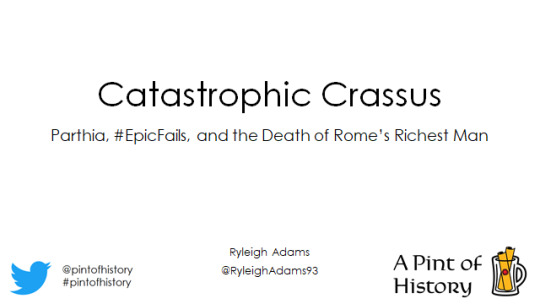

Although remembered for being Rome’s richest man, Marcus Licinius Crassus was also a successful politician who made his way up through the ranks to hold his first consulship in 70 BCE. He was considered by his contemporaries to be a quiet, straight-forward speaker in the law courts of the time, and as a general, he was known for his zeal and courage in the civil war of 83 and 82 BCE, and a decade later he was instrumental in suppressing the servile revolt led by Spartacus where others had failed. He was an ambitious man – he sought power, as did all leading men in Rome. It led him to form a partnership in 59 BCE, known as the first triumvirate

The triumvirate was an amicitia, an unofficial coalition between two leading politicians – Crassus and Pompeius – and a then junior politician, Caesar, whose death you may be more familiar with than his life.

Essentially, the triumvirate was a personal agreement formed so they could work towards their own political ends. Who was responsible for forming the coalition? Well, that depends on who you ask, and I’m not going to add to the debate today. The important thing is to understand what motivated Crassus to take part in this alliance.
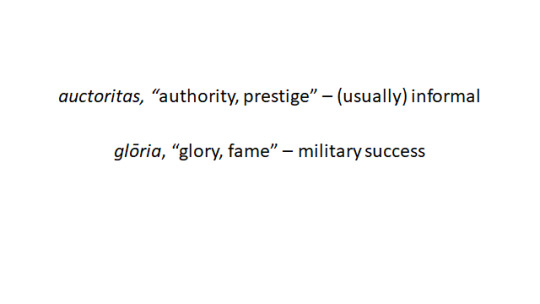
Power in Rome was influenced by auctoritas gained in political and military pursuits, of which glōria was also an important influencing factor. Politically, Crassus’ career was typical for a man from a prominent family; there was little to distinguish him from his peers. Militarily, while he’d been instrumental in repressing the servile revolt, Pompeius stole some of his thunder by arriving at the last minute and slaughtering thousands of the adversary as they fled. And, because the victory was over slaves, it wasn’t deemed as worthy as an international conquest. Crassus saw Parthia as an opportunity, a challenge. Success would mean a triumph and recognition of his prowess as a general. It would also add to his personal prestige and wealth.
The Expedition
So, with the help of his fellow triumvirs, Crassus received Syria as his province in 55 BCE. provincia was not a geographical descriptor as we understand it today. Instead, it was a responsibility assigned to Roman officials that could be militaristic or administrative in nature. In the case of Syria, Crassus recognised the potential to open opportunities as far as Bactria, India, and the Outer Ocean but there was no mention of war with Parthia in the law which gave Crassus his command. His intent was still evident, as Plutarch tells us: “there was a considerable part who objected strongly to the idea of a man going out to make war on people who, so far from having done any harm to the Romans, were bound to them by treaties of friendship.” (Plutarch, Crassus 16)

But Parthia was in a state of civil war, making conditions ideal for intervention. Orodes, the ruler at the time of Crassus’ arrival in the east, stood undisputed, but his throne was insecure. The unrest, it was argued, represented a threat to Roman interests in the area, although analysis of the sources suggests this argument was weak at best: Parthia’s preoccupation with internal disturbances effectively prevented indulgence in international adventures. But, like Gabinius before him, Crassus used a perverted interpretation of his provincial command to attack Parthia who Cicero, our only contemporary source, numbered among the most peaceful of nations.
Indeed our sources, most of which have the advantage of hindsight, believe that Crassus’ expedition was doomed from the start. Crassus supposedly ignored every bad omen, from a violent lightning storm, to the eagle on the first standard raised facing about on its own accord. Ateius, one of the tribunes of the time, even cursed Crassus’ expedition – an event Cicero confirms in his writings.
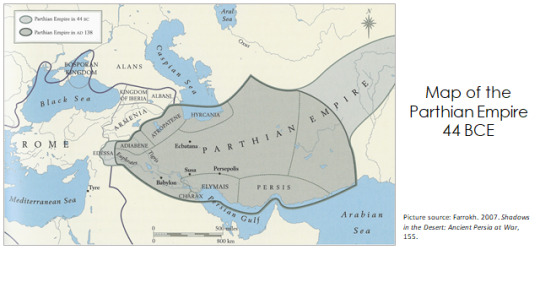
Yet Crassus pressed on, and Parthia, despite the threat of invasion, wanted to maintain the friendly terms they’d enjoyed with Rome for some thirty years. As Plutarch tells us, ambassadors came to Crassus from Arsaces [Parthia] with a short message: “If, they said, this army had been sent out by the Roman people, then it meant war to the bitter end with no question of negotiations. But if, as they had been informed, the fact was that Crassus, for his own private profit and against the wishes of his countrymen, had invaded Parthia and occupied Parthian territory, then Arsaces was prepared to adopt a reasonable attitude: he [Orodes] would take pity on Crassus as an old man, and as for his soldiers, who were rather in the position of Crassus’ prisoners than his protectors, he would allow them to go back to Rome.” (Plutarch, Crassus 18)
Defeat
As you probably guessed by the title, Crassus’ expedition did not fare well. According to tradition, he made three major mistakes which contributed to his downfall. First, after crossing into Mesopotamia in 54 BCE:

He failed to follow through with an assault on Seleucia and Ctesiphon, despite successfully capturing one city and receiving the surrender of several others.
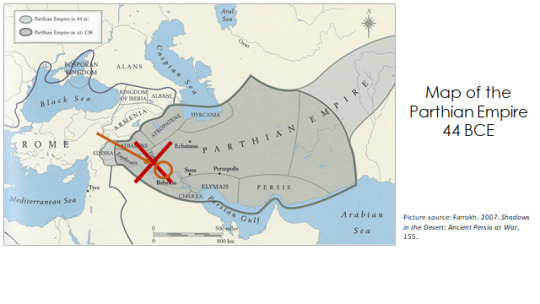
He instead chose to withdraw to Syria for the winter:

This gave the Parthians time to prepare for his impending attack. Crassus also ignored the King of Armenia’s advice to march through Armenia where he would be well supplied and could march in safety, protected by the mountains and country generally unsuited to cavalry operations:

Instead, Crassus listened to the advice of a treacherous pretend ally and abandoned the Euphrates river – his supply line. He then marched across the arid plains of central Mesopotamia to meet the Surena, the Parthian General, and his army:
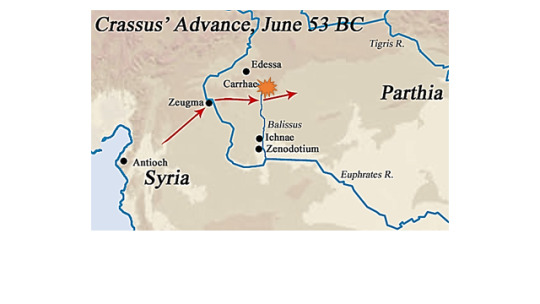
Although Crassus’ army boasted seven infantry legions plus four thousand auxiliary cavalry and light-armed troops (outnumbering Parthia’s army) they were ill-prepared to face the all-cavalry force of the Parthians. The combination of cataphracts – heavy-armed cavalry – and mounted archers proved unstoppable. When the two forces met at a location near Carrhae, the Parthian cataphracts and mounted archers overpowered Crassus’ mainly infantry force.
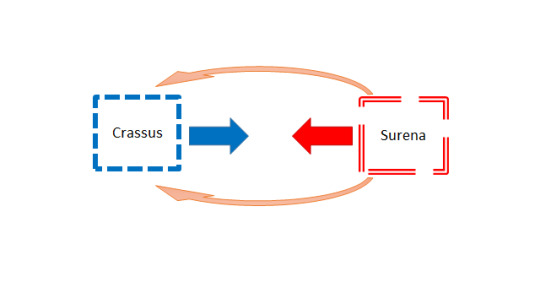
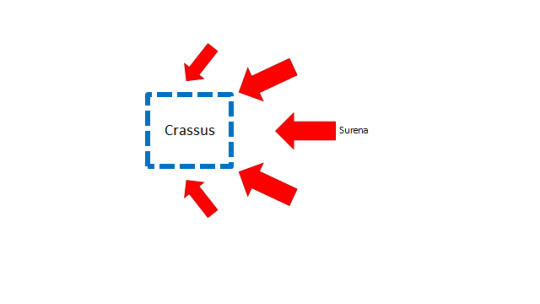
Crassus, fearing he would be entirely surrounded, sent a message to his son asking him to join the battle. Publius, with 1,300 cavalry, 500 archers, and 8 cohorts from the infantry led them forward. Upon seeing the advance, the Parthians who were trying to encircle Crassus turned back, drawing Publius away from his father.
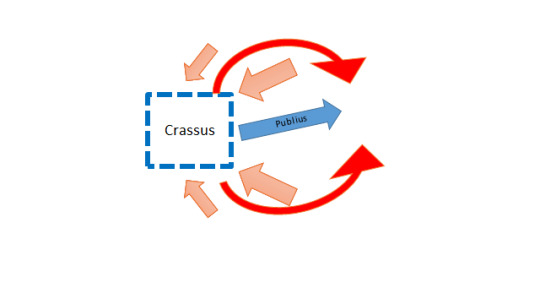
Crassus received news of his son’s dire situation, but before he and his remaining forces could reach Publius, Parthian men came carrying the head of Publius fixed on a spear – it was this sight, Plutarch tells us, that “broke the spirit and paralysed the energies of the Romans.” (Plutarch, Crassus 26)
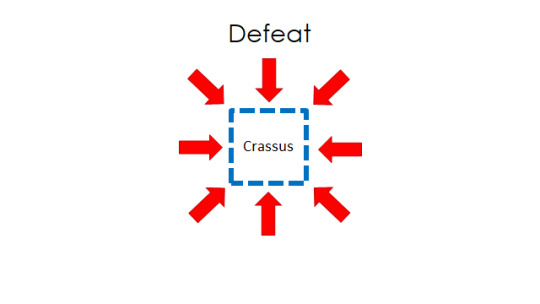
At nightfall, they withdrew to bury their dead and tend to the wounded and dying.

Following the battle, the Surena approached Crassus, who had taken refuge on a hill. He came in person to offer a truce. He said, Plutarch tells us, “that from now on a state of peace existed between King Hyrodes and the Romans; it was necessary, however, to go forward as far as the river [Euphrates] and have the terms of agreement put into writing. ‘We find,’ he added, ‘that you Romans have not got very good memories about the terms of treaties.’” (Plutarch, Crassus 31). Once Crassus came down from his position, however, a brawl broke out between the groups, and a Parthian killed Crassus. The Surena then took his head and hand as he lay on the ground, sending it to Hyrodes.
So, to put it shortly. Ouch.

Crassus’ defeat remained a great source of shame and humiliation for the Romans centuries later, and Romans agreed that the great blow to their prestige and power could only be avenged by a successful war, an attitude which influenced Roman policy towards Parthia for decades. Crassus’ loss was truly a Roman #EpicFail.
To finish off, and perhaps lighten the mood, here’s a quick summary of Crassus’ misadventure:
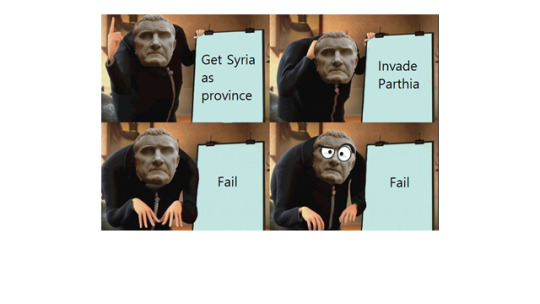
Select Bibliography:
Cassius Dio, Roman History. Translated by Earnest Cary. 1914. London: William Heinemann.
Cicero, De Divinatione. Translated by William Armistead Falconer. 1932. Cambridge MA: Harvard UP.
Plutarch, Life of Crassus. Translated by Rex Warner. 2005. London: Penguin Books Ltd.
Keaveney, A. 1982. “The King and the War-Lords: Romano-Parthian Relations Circa 64-53 B.C.” The American Journal of Philology 103.4: 412-428.
Mattern-Parkes, S. P. 2003. “The Defeat of Crassus and the Just War.” The Classical World 96.4: 387-396.
Simpson, A. D. 1938. “The Departure of Crassus for Parthia.” Transactions and Proceedings of the American Philological Association 69: 532-541.
Further reading:
Marshall, B. A. 1976. Crassus: A Political Biography. Amsterdam: Adolf M. Hakkert.
Ward, A. M. 1977. Marcus Crassus and the Late Roman Republic. Columbia: University of Missouri Press.
#classics#tagamemnon#tagitus#military monday#militarymonday#theme#daily theme#crassus#marcus licinius crassus#rome#ancient rome#roman republic#republic#late republic#roman history#history#ancient history#ancient roman history#a pint of history#presentation#my presentation#my work#sassy's scholarship#meme#classics meme#powerpoint#slides#images#parthia#crassus' parthian campaign
48 notes
·
View notes
Text
Deakin Student and Academic staff Applications for the 2019 voyage on the Marine National Facility RV Investigator
The second Collaborative Australian Postgraduate Sea Training Alliance Network (CAPSTAN) programme voyage is scheduled to depart Hobart, Tasmania on the 26thApril, arriving in Perth, 9th May 2019. Deakin University has secured at least one berth available to third year students undertaking Honours in 2019, current Honours and Masters students. There is also a call for academics (including PHDs!) that are interested in joining the voyage as trainers.
This training voyage, on the research vessel RV Investigator, will consist of practical hands-on research, sea training, theoretical lectures and an assessment of your ability to communicate scientific findings and ideas. It won’t be all hard work though, as there will be a number of fun activities along the way. The voyage will help to develop your skills and experience in many of the following: water mass identification, seafloor and sediment interpretation, acoustic interpretation, atmospherics, biology, and interpretation of underway data. This is a great opportunity to test your research, inquiry, problem-solving and communication in a unique work environment.
The CAPSTAN course includes on-line material two weeks prior to the voyage, and a pre-departure workshop on the 26th April. Most costs are covered (accommodation, flights, etc). All short-listed applicants must pass a MNF medical to be approved to sail.
If interested please contact me (Dan!) for an application form. You will need to send your application to [email protected] and an internal copy for internal ranking to Associate Professor Daniel Ierodiaconou at [email protected] by Sunday the 30th September. Email Dan if you have any questions or contact the CAPSTAN secretariat direct at [email protected]. More details at https://goto.mq/6grgeR
cheers
Dan
1 note
·
View note